 полная версия
полная версияHandwork in Wood

William Noyes
Handwork in Wood
FOREWORD
This book is intended primarily for teachers of woodwork, but the author hopes that there will also be other workers in wood, professional and amateur, who will find in it matter of interest and profit.
The successful completion of the book is due chiefly to the untiring assistance of my wife, Anna Gausmann Noyes, who has made almost all of the drawings, corrected the text, read the proof, and attended to numberless details.
Acknowledgments are hereby thankfully given for corrections and suggestions in the text made by the following persons:
Mr. Chas. W. Weick of Teachers College, and Mr. W. F. Vroom of Public School No. 5, of New York City, for revision of Chapters IV and V on tools and fastenings.
Mr. Clinton S. VanDeusen of Bradley Polytechnic Institute, for revision of Chapter X on wood finishing.
The Forest Service, Washington, D. C. for the originals of Figs. 1, 2, 3, 5, 7, 8, 9, 10, 11, 13, 17, 18, 21, 22, 23, 24, 26, 27, 28, 29, 31, 33, and 54.
The New York State Forest Fish and Game Commission for the originals of Figs. 12, 14, 15, and 47.
T. H. McAllister of New York for the originals of Figs. 16 and 20.
The Detroit Publishing Company for the original of Fig. 6.
The B. F. Sturtevant Company, Hyde Park, Mass., for the original of Fig. 57.
Doubleday, Page & Co. for the original of Fig. 30.
Mr. Louis A. Bacon, Indianapolis. Ind., for the clamping device shown in Fig. 255.
Sargent & Company, New Haven, Conn., W. C. Toles & Company, Chicago, Ill., The Berlin Machine Works, Beloit, Wis., A. A. Loetscher, Dubuque, Iowa, and the Stanley Rule and Level Co., New Britain, Conn., for electrotypes.
Allis Chalmers Company, Milwaukee, Wis., Clark Brothers, Belmont, N. Y., The M. Garland Company, Bay City, Mich., The Prescott Company, Menominee, Mich., for illustrations of sawmilling machinery.
And most of all, I wish to acknowledge my obligation to the numerous writers of whose books and articles I have made free use, to which references are made in the appropriate places.
GENERAL BIBLIOGRAPHY
Adams, Henry, Joints in Wood-Work. London: 60 Queen Victoria St. 1894.
Alexander, Jerome, The Grading and Use of Glue. Wood Craft, 5: 168, Sep. '06.
Bailey, Charles H., A Study of Manual Training Equipments. Manual Training Magazine, 6: 82. Jan. '05.
Barnard, Charles, Tools and Machines. N. Y.: Silver, Burdett and Co. 1903.
Barter, S. M., Woodwork. London: Whittaker and Co. 1892.
Benson, W. A. S., Elements of Handicraft and Design. London: Macmillan and Co. 1893.
Brannt, W. T., Painter, Gilder and Varnisher. Philadelphia: H. C. Baird & Co. 1893.
Bruncken, Ernest, North American Forests and Forestry. N. Y.: G. P. Putnam's Sons. 1899.
Clark, R. I., Varnish and Fossil Remains. London: Chas. Letts & Co. No date.
Compton, A. G., First Lessons in Woodworking. N. Y.: Ivison, Blakeman, Taylor and Co. 1888.
Crawshaw, Fred D., Problems in Furniture Making. Peoria. Ill.: The Manual Arts Press. 1906.
Disston, Henry, and Sons, Handbook for Lumbermen. Philadelphia, Pa.
Dunlap, Frederick. Kiln-drying Hardwood Lumber. Wood Craft, 6: 133, Feb. '07.
Ellis, George, Modern Practical Joinery. London: B. T. Batsford, 486 pp., 1902, '03, '04 and '07.
Encyclopedia Britannica, Lac, Varnish. N. Y.: Scribner's. 1878.
Foster, Edwin W., Elementary Woodworking. Boston: Ginn and Co.
Goss, W. F. M., Bench Work in Wood. Boston: Ginn and Co. 1887 and 1905.
Griffith, Ira S., Essentials of Woodworking. Peoria Ill.: Manual Arts Press. 1908.
Hammacher, Schlemmer & Co., Tools. Catalog No. 355. N. Y. 1908.
Hammacher, Schlemmer & Co., Cabinet Hardware. Catalog No. 151. N. Y. 1904.
Hodgson, Fred T., The Up-to-date Hardwood Finisher. Chicago: Fred J. Drake and Co. 1904.
Hodgson, Fred T., The Carpenter's Steel Square and Its Uses. N. Y.: Industrial Publishing Co. 1880.
Hovey-King, Alvin, The Lumber Industry of the Pacific Coast. Review of Reviews, 27: 317, Mr., '03.
Hulbert, W. H., The Lumber Jack and His Job. Outlook, 76: 801, Ap. 2, '04.
International Correspondence School, The Building Trades Pocketbook. Scranton, Pa. International Textbook Co. 2nd edition. 1905.
International Encyclopedia, Lac-Insect Varnish. N. Y.: Dodd, Mead and Co. 1902-1904.
Jones, J. E., Lumbering in the Northwest. Cosmopolitan, 15: 63, May 1893.
Larsson, Gustaf, Elementary Sloyd and Whittling. N. Y.: Silver, Burdett & Co. 1906.
Maire, F., The Modern Wood Finisher. Chicago: Press of the Western Painter.
Munn, M. J., Great Industries of the U. S.—Lumber. Cosmopolitan, 37: 441, Aug. '04.
Murray, M. W., Problems in Wood-working. Peoria, Ill.: Manual Arts Press. 1905.
Murray, M. W., The Manual Training Room and Its Equipment. Year Book of the Council of Supervisors for 1906, pp. 69-86.
Park, Joseph C. Educational Woodworking for School and Home. The Macmillan Co., 1908.
Pichot, Gifford, A Primer of Forestry. Parts I and II, U. S. Dept. of Agric. For. Serv. Bull. No. 24. 1899 and 1905.
Purfield, H. T., The Length of Nails. Wood Craft, 5: 181, Sp. '06.
Rivingston, see South Kensington Council on Education.
Rouillion, Louis, Economies of Manual Training. N. Y.: The Derry Collard Company. 1905.
Roth, Filibert, A First Book of Forestry. Boston: Ginn & Co. 1902.
Sargent & Co., Standard Steel Squares. New Haven, Conn.
Seaton, Geo. A., A Clamp for Use at the Grindstone. Woodcraft, 6: 96. Jan., '07.
Selden, F. H., Elementary Woodwork. N. Y.: Rand, McNally & Co. 1906.
Sickels, Ivin, Exercises in Woodworking. N. Y.: D. Appleton & Co. 1889.
Smith, K., Lumbering by Machinery. World's Work, 7: 4435. Feb. '04.
Smith, R. H., Cutting Tools. London: Cassell & Co. 1884.
South Kensington Council on Education, Notes on Building Construction. 3 vols. London: Rivington. 1883-1889.
Standage, H. C., Glues and Cements for the Use of Woodworkers. Wood Craft, 7: 48, May, '07.
Tate, James M., Training in Wood Work. Minneapolis: North Western School Supply Co. About 1905.
Trout, W. H., The Modern Saw Mill. Cassier's Magazine, 11: 83-95. 184-195, Dec. '96 and Jan. '97.
U. S. Department of Agriculture Forest Service Classified List of Publications. Forest Service Bulletins:
No. 10. Filibert, Roth. Timber. 1895.
No. 34. Wm. F. Fox, A History of the Lumber Industry in the State of New York, 1902.
No. 41. Hermann von Schrenk, Seasoning of Timber. 1903.
Van Deusen, Clinton S., Methods of Wood Finishing. Manual Training Magazine, 6: 93. Jan. '05.
Van Deusen, Clinton S., Logging in the South. Manual Training Magazine, 1: 93. Jan. '00.
Wheeler, C. G., Woodworking for Beginners. N. Y.: G. P. Putnam's Sons. 1899.
White, Stewart Edward, The Blazed Trail. N. Y.: McClure, Phillips & Co. 1904.
White, Stewart Edward, From Forest to Saw Mill. Junior Munsey, 10: 362, Je. '01.
Anonymous.
Nails. Wood Craft. 5: 103, Jl. '06.
A Dry-Kiln of Progressive Style. Wood Craft, 6: 31. Nov. '06.
Lumbering in Louisiana. Wood Craft, 4: 55, Nov. '05.
The Lac Industry of Assam. Journal of the Society of Arts. 49: 192. Feb 8 '01.
Chapter I.
LOGGING
The rough and ready methods common in American logging operations are the result partly of a tradition of inexhaustible supply, partly of the fear of fire and the avoidance of taxes, partly of an eagerness to get rich quick. Most of the logging has been done on privately owned land or on shamelessly stolen public land, and the lumberman had no further interest in the forest than to lumber it expeditiously.
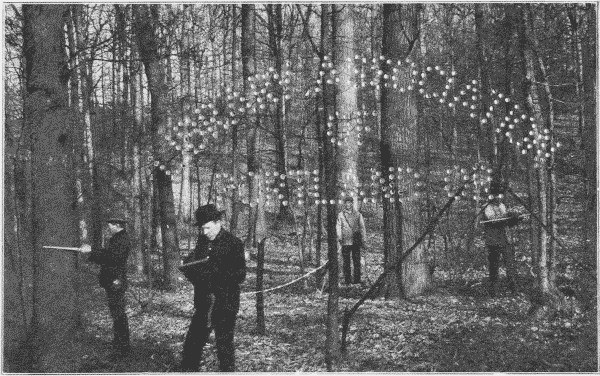
Fig. 1. Making a Valuation Survey.
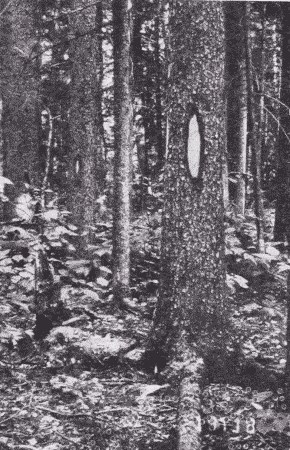
Fig. 2. "Blazes" on Trees.
Preliminary to the actual logging are certain necessary steps. First of all is landlooking. This includes the survey of the forest land for the purpose of locating good timber. Fig. 1. Most of the woodland has previously been roughly surveyed by the government and maps made indicating which parts are private land and which are still held by the government. The boundaries of townships, sections, quarter sections, eighties, forties, etc., are indicated by "blazes" on trees, Fig. 2, so that the "cruiser" or "looker" as he goes thru the woods can identify them with those on his oil paper map. The cruiser also studies the kinds and character of the trees, the contour of the ground, the proximity to streams,—all with the view to marketing the product. Acting on the information thus gained by the cruiser, the lumberman purchases his sections at the proper land office, or if he is less scrupulous, buys only enough to serve as a basis for operations. Enormous fortunes have been made by timber thieves, now respectable members of the community. As a further preliminary step to lumbering itself, the tote road and camp are built. The tote road is a rough road on which supplies for crew and cattle can be taken to camp from civilization.
It is barely passable for a team and a wagon, but it serves its purpose, and over it come more men and horses. Lumber for the floors and roofs of the shanties and for the rude pieces of furniture that will be needed, tarred paper to make the roofs tight, a few glazed window sashes, a huge range and a number of box stoves, dishes and kitchen utensils, a little stock of goods for the van, blankets by the dozen and score, and countless boxes and barrels and bags of provisions.1
The camp itself, Fig. 3, is built of logs, roofed with plank, covered with heavy tar paper, and dimly lighted. There are usually five buildings,—the men's camp, the cook camp, the office, the barn, and the blacksmith's shop. Many camps accommodate from eighty to one hundred men. The men's camp is filled with bunks and is heated by a stove and in general roughly furnished. Cooking and eating are done in the cook camp, where the cook and his assistant, the "cookee," sleep. The office is occupied by the foreman, log-sealers and clerks. Here the books and accounts are kept, and here is the "van," stocked with such goods as will supply the immediate needs of the lumber jacks.
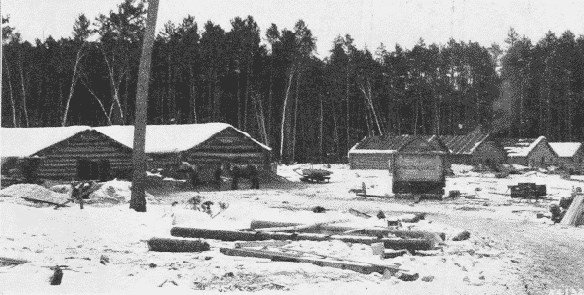
Fig. 3. Winter Logging Camp. Itasco County, Minnesota.
Before winter sets in the main road is built, Fig. 15, p. 17, very carefully graded from the camp down to the nearest mill or railway siding, or oftener to the stream down which the logs are to be floated. This road has to be as wide as a city street, 25 feet. The route is carefully chosen, and the grade is made as easy as possible. Much labor is spent upon it, clearing away stumps and rocks, leveling up with corduroy, building bridges strong enough to carry enormous loads, and otherwise making it as passable as can be; for when needed later, its good condition is of first importance. This main road is quite distinct from and much superior to the tote road.
At intervals alongside the main road, small squares called skidways are cleared of brush and in each of them two tree trunks, "skids," are laid at right angles to the road. On these the logs, when cut later, are to be piled. Back from the skidways, into the woods the swampers cut rough, narrow roads called dray roads or travoy roads,—mere trails sufficiently cleared of brush to allow a team of horses to pull a log thru.

Fig. 4. Tools used in Logging.
All these are operations preliminary to the felling of trees. The tools commonly used in logging are shown in Fig. 4. When everything is ready for felling, the "fitter" goes ahead marking each tree to be felled and the direction in which it is to fall by cutting a notch on that side. Then come the sawyers in pairs, Fig. 5. First they chop a deep gash on the side of the tree toward which it is to fall, and then from the opposite side begin cutting with a long, Tuttle-tooth, crosscut-saw. The saw is a long, flexible ribbon of steel, with handles so affixed to each end that they can be removed easily. The cut is made on the pulling stroke, and hence the kerf can be very narrow. As soon as the saw is well within the trunk, the sawyers drive iron wedges into the kerf behind it, partly to keep the weight of the trunk from binding the saw, and partly to direct its fall. Then the saw is pulled back and forth, and the wedges driven in farther and farther, until every stroke of the maul that drives them sends a shiver thru the whole tree. Just as the tree is ready to go over, the saw handle at one end is unhooked and the saw pulled out at the other side. "Timber!," the men cry out as a warning to any working near by, for the tree has begun to lean slightly. Then with a hastening rush the top whistles thru the air, and tears thru the branches of other trees, and the trunk with a tremendous crash strikes the ground. Even hardened loggers can hardly keep from shouting, so impressive is the sight of a falling giant tree.
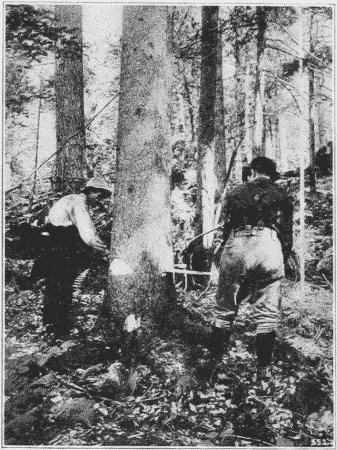
Fig. 5. Felling Red Spruce with a Saw.
Adirondack Mountains, New York.
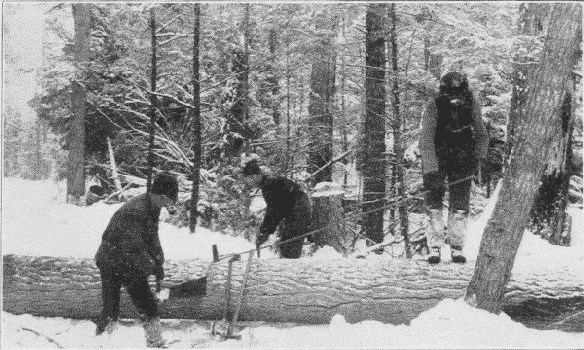
Fig. 6. Sawing Logs into Lengths.
All this seems simple enough in outline, but the actual execution requires considerable skill. Trees seldom stand quite vertical, there is danger of lodging in some other tree in thick woods, and it is therefore necessary to throw trees quite exactly. Some men become so expert at this that they can plant a stake and drive it into the ground by the falling trunk as truly as if they hit it with a maul. On the other hand, serious accidents often happen in falling trees. Most of them come from "side winders," i. e., the falling of smaller trees struck by the felled trees.
After "falling" a tree, the sawyers mark off and saw the trunk into log lengths, Fig. 6, paying due attention to the necessity of avoiding knots, forks, and rotten places, so that some of the logs are eighteen feet, some sixteen feet, some fourteen feet, and some only twelve feet in length. Meanwhile the swampers trim off the branches, Fig. 7, a job requiring no little skill, in order that the trunk may be shaved close but not gashed.

Fig. 7. Trimming off Branches of Spruce.
Adirondack Mountains, New York.
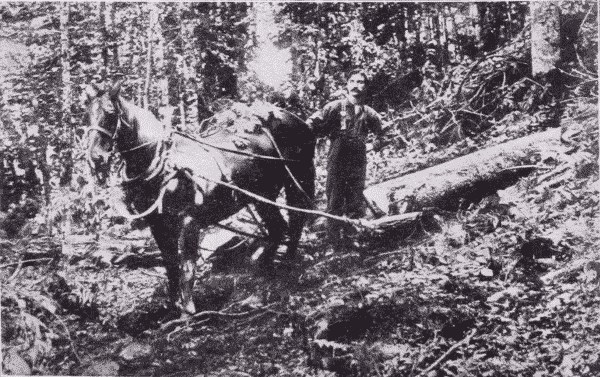
Fig. 8. Hauling Spruce Logs to the Skidway.
Adirondack Mountains, New York.
This finishes the second group of operations, the felling. Next the logs are dragged out to the dray roads, Fig. 8. A heavy pair of tongs, like ice-tongs, is attached to one end, and the log is snaked out by horses to the skidway. If the log is very heavy, one end is put on a dray. By one way or another the log is dragged out and across the two parallel skids, on which it is rolled by cant-hooks to the end of skids toward the road way. If other logs already occupy the skids, each new log as it arrives is piled on the first tier. As the pile grows higher, each log is "decked," that is, rolled up parallel poles laid slanting up the face of the pile, by means of a chain passed under and over the log and back over the pile, Fig. 11. A horse hitched to the end of the chain hauls up the log, which is guided by the "send-up men" with their cant-hooks.
Once piled the logs are "scaled," that is measured in order to compute the number of board feet in them, Fig. 9. The scaler generally has an assistant, for logs in large piles must be measured at both ends in order to determine which is the top, the body of the log being out of sight. When measured each end of the log is stamped with a hammer with the owner's mark, by which it can afterward be identified. Here the logs rest and the felling and skidding continue until deep snow falls and then the sleigh haul begins.
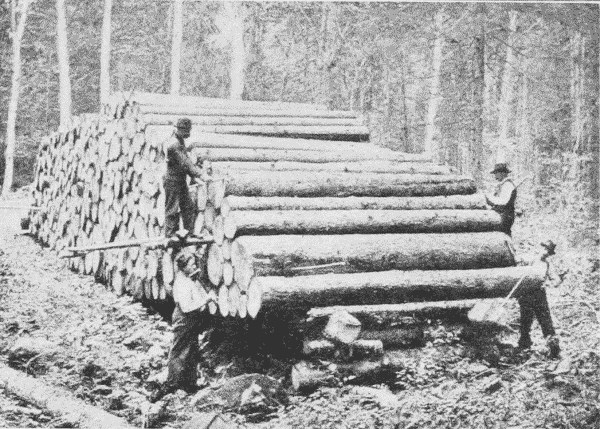
Fig. 9. "Scaling" Logs on the Skids.

Fig. 10. Making an Ice Road by Flooding.
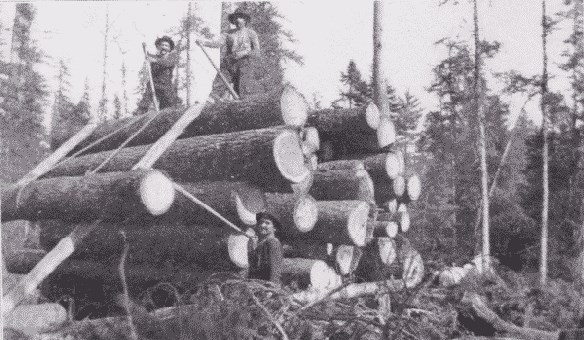
Fig. 11. Decking Logs on Skidway.
For this the main road is especially prepared. First the road is carefully plowed with an immense V plow, weighted down by logs. To the plow are attached fans. Only an inch or two of snow is left on the ground by this plow, which is followed by another special plow to gouge the ruts, and by a gang of "road monkeys" who clear the road thoroly. Then follows an immense tank set on runners and holding perhaps seventy-five barrels of water, and so arranged as to flood the road from holes in the bottom of the tank, a sort of rough road sprinkler, Fig. 10. The sprinkler goes over the road again and again until the road is covered by a clear, solid sheet of ice often two feet thick, extending from the skidways to the banking grounds. This ice road is one of the modern improvements in logging. Once finished, these roads are beautiful pieces of construction with deep, clear ruts. They have to be constantly watched and repaired, and this is the work of the "road monkeys." If possible the road has been made entirely with down grades but some of these are so steep that a man must be prepared with sand or hay to check too headlong a descent.
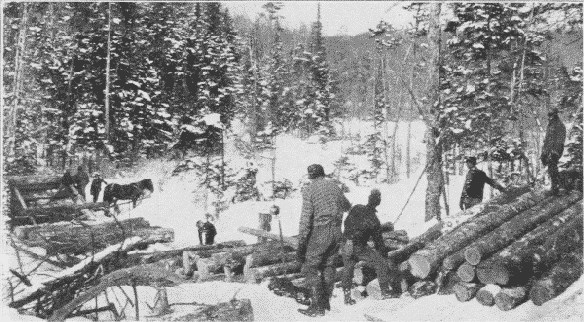
Fig. 12. Loading a Sled from a Skidway.
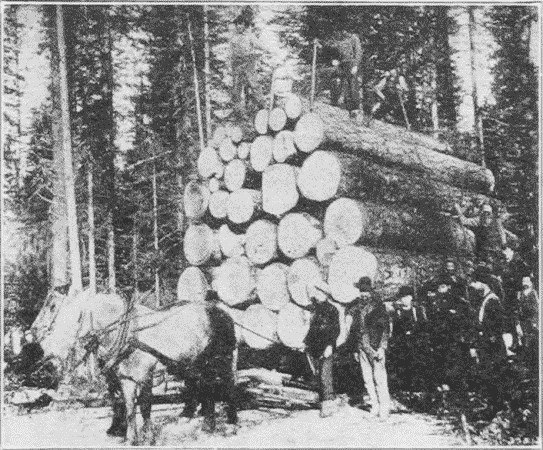
Fig. 13. A Load of Logs. Flathead County, Montana.
When all is ready the sleigh haul begins. Piling on the sleighs or bobs, Fig. 12, is similar to piling on the skidways, but more difficult, for the load has to be carefully balanced, Fig. 13. Chains bind the loads but the piling is only too apt to be defective, and the whole load "squash out" with a rush. It is a time of feverish activity. The sprinklers are at work till after midnight, the loaders are out long before daylight. The blacksmith is busy with repairs, the road monkeys work overtime, and the cook works all the time. "Everybody works." The haul itself is full of excitement. The ponderous load of logs, weighing anywhere from eight to thirty-five tons has to be conducted largely by its own momentum down this glassy road. If a horse fall nothing can save its life. If the runners get out of the ruts, the whole load, driver and all, is likely to be upset. It is an extremely hazardous job, Fig. 15.
As each load comes down to the banking grounds, Fig. 14, or log dump, it is stopped opposite long parallel skids. The wrapping chains are unhooked and the lower log on the skid side is worked out with cant-hooks till the whole load flattens out. The logs are then "decked" on immense piles, sometimes a mile long and filling the whole river from bank to bank. A decking chain 300 feet long is sometimes required to roll the logs to their proper places. Here the logs rest till the spring freshets come. This completes the transportation by land.
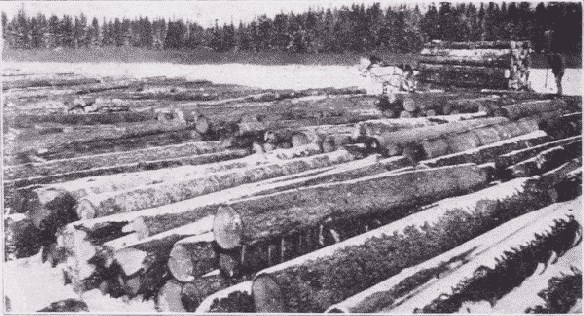
Fig. 14. Banking Grounds.
With the coming of the spring thaw, the river bed is filled with a freshet of water which seizes and carries the logs down stream. Many on the banks, however, have to be started on their way, and this is called "breaking out the roll ways." They often start on their water journey with a great crash.

Fig. 15. The Sleigh Haul.
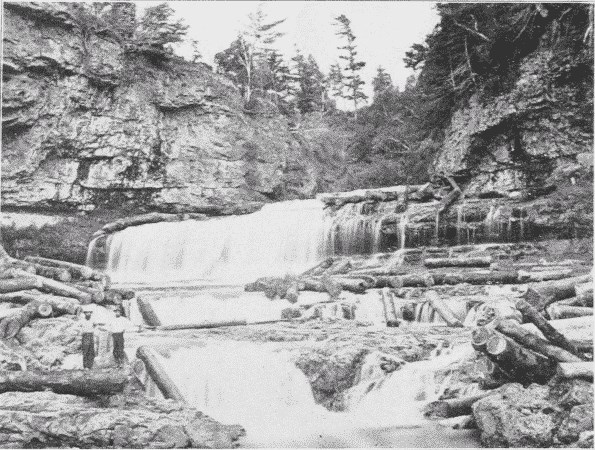
Fig. 16. Sacking the Rear.
Now comes the drive, an arduous and often perilous task. Some of the men are stationed along the shores to prevent the logs from lodging or floating into bays or setbacks. Some stand at the heads of bars or islands, where with pike poles they shove off the logs that might stop there and form a jam; others follow "sacking the rear" to clean out such logs as may have become stranded. This "sacking the rear" takes most of the time, Fig. 16. While "on the drive" men often work fourteen hours a day, a good part of the time up to their waists in ice water. Their boots are shod with "caulks," or spikes, to keep them from slipping on the logs, and they carry either pike poles or peaveys, Fig. 17. The latter are similar to cant-hooks, except that they have sharp pikes at their ends. So armed, they have to "ride any kind of a log in any water, to propel a log by jumping on it, by rolling it squirrel fashion with the feet, by punting it as one would a canoe; to be skilful in pushing, prying, and poling other logs from the quarter deck of the same cranky craft." Altho the logs are carried by the river, they have to be "driven" with amazing skill and bravery.
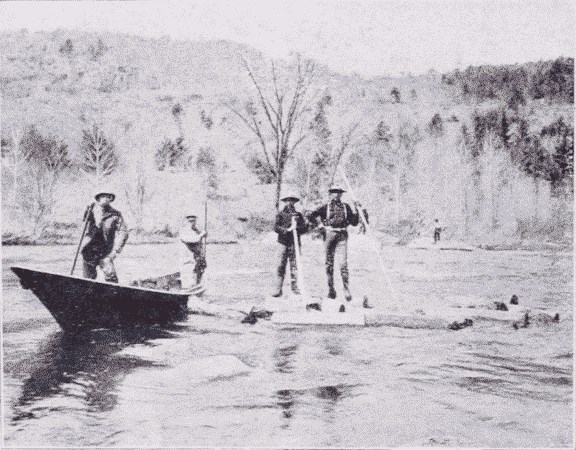
Fig. 17. Log Driving on the Ausable River.
The climax of hardship and courage is reached when a "jam" is formed, Fig. 18. Sometimes one or two logs are caught in such a way as to be locked or jammed and then soon other logs begin to accumulate behind them, till the whole river is full of a seemingly inextricable mass. Sometimes these jams can be loosened by being pulled apart, one log at a time. A hundred men can pull out an amazing number of logs in a day. The problem always is to set free or cut out certain "key" logs, which lock the whole mass. Following is a description by Stewart Edward White of the breaking of such a jam:
The crew were working desperately. Down on the heap somewhere, two logs were crossed in such a manner as to lock the whole. They sought those logs.
Thirty feet above the bed of the river six men clamped their peaveys into the soft pine; jerking, pulling, lifting, sliding the great logs from their places. Thirty feet below, under the threatening face, six other men coolly picked out and set adrift one by one, the timbers not inextricably imbedded. From time to time the mass creaked, settled, perhaps even moved a foot or two; but always the practised rivermen, after a glance, bent more eagerly to their work. * * * Suddenly the six men below the jam scattered. * * * holding their peaveys across their bodies, they jumped lightly from one floating log to another in the zig-zag to shore. * * *
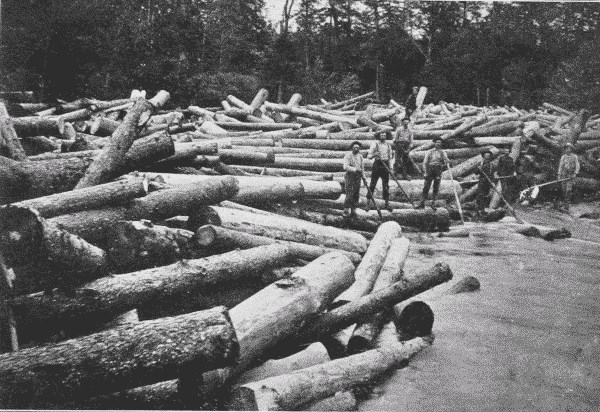
Fig. 18. Log Jam. Adirondack Mountains, New York.
In the meantime a barely perceptible motion was communicating itself from one particle to another thru the center of the jam. * * * The crew redoubled its exertion, clamping its peaveys here and there, apparently at random, but in reality with the most definite of purposes. A sharp crack exploded immediately underneath. There could no longer exist any doubt as to the motion, altho it was as yet sluggish, glacial. Then in silence a log shifted—in silence and slowly—but with irresistible force * * * other logs in all directions up-ended. * * *



